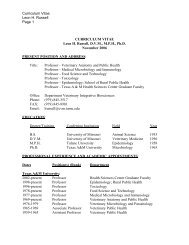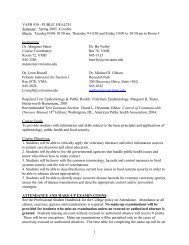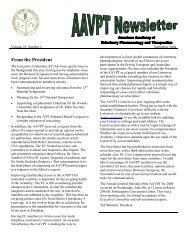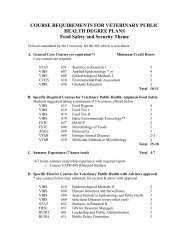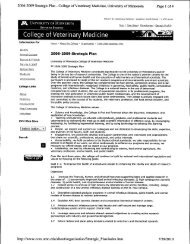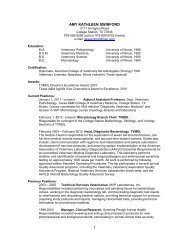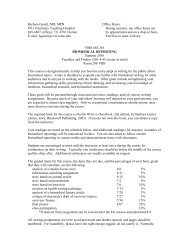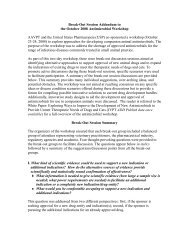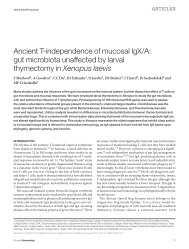Download PDF - College of Veterinary Medicine - Texas A&M ...
Download PDF - College of Veterinary Medicine - Texas A&M ...
Download PDF - College of Veterinary Medicine - Texas A&M ...
You also want an ePaper? Increase the reach of your titles
YUMPU automatically turns print PDFs into web optimized ePapers that Google loves.
Faculty/Staff Focus<br />
Old deer, new tricks: Seabury applies<br />
sequencing to the white-tailed deer<br />
Together with his research team,<br />
Dr. Christopher M. Seabury, assistant<br />
pr<strong>of</strong>essor in the Department <strong>of</strong><br />
<strong>Veterinary</strong> Pathobiology at the <strong>Texas</strong><br />
A&M <strong>College</strong> <strong>of</strong> <strong>Veterinary</strong> <strong>Medicine</strong> &<br />
Biomedical Sciences (CVM), has used<br />
next generation sequencing technologies<br />
to develop a working comparative<br />
knowledge <strong>of</strong> the white-tailed deer<br />
genome. Their paper, “Genome-Wide<br />
Polymorphism and Comparative Analyses<br />
in the White-tailed Deer (Odocoileus<br />
virginianus): A Model for Conservation<br />
Genomics,” was recently published<br />
in PLoS ONE. It included a complete<br />
mitochondrial genome sequence assembly<br />
as well as a survey <strong>of</strong> nuclear<br />
genome sequences from both southern<br />
and northern white-tailed deer.<br />
Before Seabury’s publication, no<br />
large-scale genomics research had<br />
been done on this species, in part because<br />
<strong>of</strong> inadequate funding. Seabury<br />
and his team strongly believe in the importance<br />
<strong>of</strong> developing species-specific<br />
genomic tools and resources for the<br />
white-tailed deer, so such studies need<br />
not rely on technologies and resources<br />
borrowed from domestic cattle and<br />
sheep. Seabury’s efforts are driven<br />
mainly by burgeoning wild and captive<br />
white-tailed deer populations in <strong>Texas</strong><br />
and nationally, a strong economic<br />
impact surrounding white-tailed deer<br />
related to agribusiness, and a myriad<br />
Dr. Christopher M. Seabury<br />
<strong>of</strong> interesting biological characteristics,<br />
such as adaptability, fecundity, and differential<br />
susceptibility to disease.<br />
Relevant to Seabury’s recent study, a<br />
2007 study by agricultural economists<br />
from <strong>Texas</strong> A&M determined that<br />
farmed white-tailed deer ranked sixth<br />
in agricultural products, bringing in<br />
$652 million to the <strong>Texas</strong> economy,<br />
with a national economic impact in excess<br />
<strong>of</strong> $3 billion. White-tailed deer are<br />
distinctive in that they occur as both<br />
free ranging wildlife species and captively<br />
propagated agricultural species.<br />
Given the obvious economic impact <strong>of</strong><br />
activities related to white-tailed deer,<br />
researchers determined that the species<br />
will be a major agricultural player<br />
for years to come.<br />
“The research represented by this<br />
publication provides a cost-effective<br />
template for rapidly developing novel<br />
and sophisticated genomics research<br />
programs for species that don’t receive<br />
a lot <strong>of</strong> funding…the so-called minor<br />
species,” Seabury said.<br />
Seabury’s research also shows that<br />
one principal investigator and a small<br />
team <strong>of</strong> other scientists can make<br />
significant progress in historically underfunded<br />
species by developing tools,<br />
resources, and methodologies. The<br />
entire deer project was carried out by a<br />
single laboratory, with one computer in<br />
Seabury’s <strong>of</strong>fice.<br />
Seabury said he hopes this research<br />
will help in managing both free-ranging<br />
and captive populations <strong>of</strong> whitetailed<br />
deer, which should benefit both<br />
breeders and molecular ecologists.<br />
Importantly, his work can be applied to<br />
other species where funding is limited.<br />
As more information and tools become<br />
available for underfunded species,<br />
Seabury anticipates his work will help<br />
generate additional funding for the<br />
white-tailed deer as well as other important<br />
non-model species.<br />
“It’s not just the deer resources and<br />
analyses, but the method and workflow<br />
that can be utilized for any wildlife<br />
or minor species,” Seabury said. “We<br />
literally took white-tailed deer genomics<br />
from a casual conversation with no<br />
tangible resources, to a sophisticated<br />
“We at the TDA are excited about<br />
the potential Seabury’s cutting-edge research<br />
has on our industry.”<br />
~ Dr. Dick Cain<br />
research program with thousands <strong>of</strong><br />
deer-specific genetic markers and comparative<br />
genome annotation in a very<br />
swift fashion.”<br />
Seabury and his team enlisted help<br />
from Dr. Don Davis, the <strong>Texas</strong> Deer<br />
Association (TDA), and the <strong>Texas</strong><br />
Parks and Wildlife Department, which<br />
provided access to DNA resources from<br />
both captive and free-ranging deer.<br />
Dr. Dick Cain, representative <strong>of</strong> the<br />
TDA, said that TDA’s relationship with<br />
<strong>Texas</strong> A&M has been longstanding.<br />
“We at the TDA are excited about<br />
the potential Seabury’s cutting-edge<br />
research has on our industry,” Cain<br />
said. “His research will give a complete<br />
genetic map <strong>of</strong> white-tailed deer, will<br />
provide the opportunity to help with<br />
reproduction, will facilitate in eliminating<br />
transmissible diseases, and provide<br />
support in treatment <strong>of</strong> disease. It<br />
holds great promise, and as a tremendous<br />
contribution to our industry, it<br />
will change the way we breed deer in<br />
the future.”<br />
Seabury said, “This paper, which utilizes<br />
cutting-edge biotechnology and<br />
computing, will forever change how<br />
we approach genomic research with<br />
respect to historically underfunded<br />
species and make large-scale genomics<br />
possible for groups with very modest<br />
research budgets, including developing<br />
countries, thereby enabling sophisticated<br />
research in many new species.”<br />
CVM Today • Winter 2012 • 47




